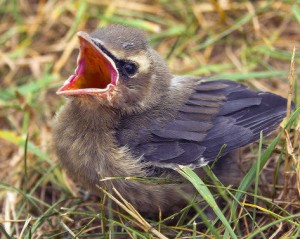What To Do If You Find A Baby Bird
 By Vernita Gundy, KSTR Volunteer Coordinator
By Vernita Gundy, KSTR Volunteer Coordinator
How many of you out there in your lifetime have found a baby bird and took it home, put it in a box and tried your best to be a substitute “Mama” bird?
Most of us who find a young bird automatically want to care and feed the bird. But did you know it is strongly recommended that you not do this? Believe it or not, you are more likely to do more harm than good. So, what do you do instead? Examine the bird for injuries, if hurt take it to a local veterinarian or call MINAE.
I’ve found an uninjured baby birds, so now what do I do?
If you find an uninjured baby bird you will need to determine whether or not it is really an orphaned bird. The best way is to determine if it is a nestling or a fledgling. Most young birds that are found are really just young fledglings that can’t fly well. In order to determine whether the bird is a nestling or a fledgling allow the baby bird to perch on your finger. If it is able to grip your finger firmly then it is a fledgling. The best thing to do in this case is to place it in a nearby tree or shrub and leave it alone. The parents will continue to care and feed it on their own.
If the bird is not able to cling to your finger then it is most likely a nestling. If this is the case, try to locate the nest because most of the time it will be close by and well hidden. Place the bird back in the nest. If the nest cannot be found, try lining a small berry basket with tissue and tying the basket to a tree. Place the young bird in the basket and leave it alone. The parents will take care of it once you leave. If cats are a problem, keep them indoors for a couple of days. If it is a neighboring cats or predators you fear, try to move the bird out of harms’ way. Move it to dense shrubbery.
Many bird deaths are caused by well-meaning people. It would be better that the young bird being caught by a predator than be tortured by a slow traumatic death caused by improper feeding and stress from a caring but uninformed individual.
Can I hand-feeding the bird I found?
The short answer is no. Young birds need to be fed every 15 to 20 minutes from sunrise to sunset and each bird species diet is different. Some bird species diet will change from the nestling phase to the fledgling phase of their development. Most people are not able to provide this much time and effort in raising young birds. Do you know exactly what the bird eats? They certainly just don’t eat worms!
Why do birds that are not able to fly, leave the nest?
To us humans, home is a warm and safe environment. For birds, the nest can be a dangerous place. Predators can attack the whole brood leaving an unsuccessful nesting season. It is in the best interest of the young birds to not only leave the nest quickly, but it helps to be spread out from one another. This aids in limiting the number of baby birds a predator might harm and giving the young the greatest chance at survival.
So, although it is understandable why one would want to help young birds, the best thing is to leave them alone. Without knowing the mental state of the young bird you are unable to know whether you are being a comfort or stressing it to death. Wild animals do not want to be petted. Without the proper license and training, your best bet is to leave wild baby birds alone. Nature, as we all know, is not always kind, but it is perfect.
Be Advised – Holding wild birds in captivity is illegal.

